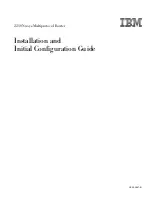
3Com Corporation
Page 78
6
G
LOSSARY
Symbols
:
802.11
:
802.11 is a family of specifications for
wireless local area networks (WLANs) developed
by a working group of the Institute of Electrical and
Electronics Engineers (IEEE). The original
specification provides for an Ethernet Media Access
Controller (MAC) and several physical layer (PHY)
options, the most popular of which uses GFSK
modulation at 2.4GHz, enabling data rates of 1 or
2Mbps. Since its inception, two major PHY
enhancements have been adopted and become
"industry standards".
802.11b adds CCK modulation enabling data rates
of up to 11Mbps, and 802.11a specifies OFDM
modulation in frequency bands in the 5 to 6GHz
range, and enables data rates up to 54Mbps.
A
AAA:
Authentication, Authorization and Accounting.
A method for transmitting roaming access requests
in the form of user credentials (typically
user@domain and password), service authorization,
and session accounting details between devices
and networks in a real-time manner.
AES:
A
dvanced
E
ncryption
S
tandard
, a symmetric
128-bit block data encryption technique. AES works
at multiple network layers simultaneously.
authentication
: The process of establishing the
identity of another unit (client, user, device) prior to
exchanging sensitive information.
B
backbone:
The primary connectivity mechanism of
a hierarchical distributed system. All systems, which
have connectivity to an intermediate system on the
backbone, are assured of connectivity to each other.
This does not prevent systems from setting up
private arrangements with each other to bypass the
backbone for reasons of cost, performance, or
security.
Bandwidth:
Technically, the difference, in Hertz
(Hz), between the highest and lowest frequencies of
a transmission channel. However, as typically used,
the amount of data that can be sent through a given
communication circuit. For example, typical
Ethernet has a bandwidth of 100Mbps.
bps
: bits per second. A measure of the data
transmission rate.
D
DHCP:
Dynamic Host Configuration Protocol
(DHCP) is a communications protocol that lets
network administrators manage centrally and
automate the assignment of Internet Protocol (IP)
addresses in an organization's network. Using the
Internet Protocol, each machine that can connect to
the Internet needs a unique IP address. When an
organization sets up its computer users with a
connection to the Internet, an IP address must be
assigned to each machine. Without DHCP, the IP
address must be entered manually at each
computer and, if computers move to another
location in another part of the network, a new IP
address must be entered. DHCP lets a network
administrator supervise and distribute IP addresses
from a central point and automatically sends a new
IP address when a computer is plugged into a
different place in the network.
DNS:
Domain Name Service. An Internet service
that translates a domain name such as 3Com
Corporation to an IP address, in the form
xx.xx.xx.xx, where xx is an 8 bit hex number.
E
EAP:
Extensible Authentication Protocol. Defined in
[RFC2284] and used by IEEE 802.1x Port Based
Authentication Protocol [8021x] that provides
additional authentication methods. EAP-TLS
(Transport Level Security) provides for mutual
authentication, integrity-protected ciphersuite
negotiation and key exchange between two
endpoints [RFC2716]. EAP-TTLS (Tunneled TLS
Authentication Protocol) provides an authentication
negotiation enhancement to TLS (see Internet-Draft
<draft-ietf-pppext-eap-ttls-00.txt>).
Содержание 3CRWE920G73
Страница 2: ......







































